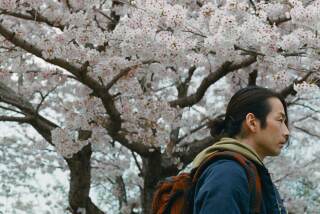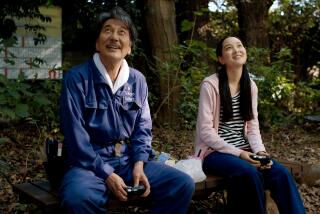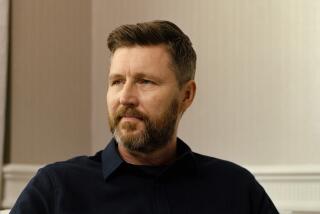Hidden neglect brought to light
- Share via
The Japanese press called it the “Affair of the Four Abandoned Children of Nishi-Sugamo,” as the nation was shocked to find out a mother had abandoned her children in their apartment.
For months in 1988, the youngsters lived alone with just a few thousand yen to subside on, and no one in the complex even realized the children were there.
This haunting story of child abuse has been fictionalized in the docudrama “Nobody Knows,” which opens Friday. Directed by Hirokazu Kore-eda (“After Life,” “Distance”), the drama revolves around a 12-year-old boy, Akira (Yuya Yagira), who becomes the man of the house when his flighty mother splits, leaving the children to fend for themselves in their tiny apartment. Yagira, now 14, won the best actor award at last year’s Cannes Film Festival for his performance.
“Nobody Knows,” says Kore-eda, was inspired by the true story, but the movie is not a factual recounting. “The settings and the ending of the story are based on the true story,” he explains through a translator. “But the emotions within the movie and what goes on is more of my creation and fictional.”
Although one rarely sees children living on the streets in modern-day Japan, says the director, youngsters are often the victims of neglect. “These families exist where children are actually abandoned within the confines of their homes. The only time that street children were spoken of or even paid attention to was directly after the war. So now there is this neglect going on, but it hasn’t come to the forefront because people aren’t talking about it.”
Kore-eda cites a number of subtle changes in Japanese culture that have transformed mothers into the parent solely responsible for their children’s well-being. The once-powerful nuclear family, he notes, has all but ceased to exist in Japan. “There is not much a sense of community or a tight-knit community,” he explains.
“Families no longer live with their relatives or grandparents, so the mother often ends up being their only caretaker. At the same time, men are considered to be the ones who should be working in the office. In a corporate society like Japan, it has become more and more apparent that there is an expectation that the woman be the child-carer, and with all this responsibility many of them end up not being able to handle the pressure.”
Kore-eda conducted extensive auditions to cast the four children, all of whom were nonprofessionals.
Though he has no children himself, he had previous experience working with youngsters.
“Fifteen years ago I spent three years filming these children at a middle school,” Kore-eda explains. “I think that is how I learned to shoot children. Also, in my previous projects, I often worked with amateurs rather than professionals. With these children I probably dealt with them in the same manner, meaning I treated them more like adults than trying to be consciously aware of them as children. In the end, that brought out good results.”
Every morning before shooting began, Kore-eda would explain the scene to the children, who ranged in age from 4 to 12 when filming began in 2002. “When we would be shooting I would go up to the children and tell them what their lines were rather than giving something in written form,” he explains.
“There is some improvisation involved in the scenes where they are playing in the park and eating,” he adds, “but otherwise most of the dialogue was the lines I had given them.”
Kore-eda spent a year filming and working on “Nobody Knows.” He would shoot over a season and then go edit the footage and then return to production. It wasn’t just to record the children’s growth and changes in the group dynamics, he says.
“It was actually more about my growth. I have a lot of experiences with documentaries, and with documentaries you go shoot and edit and prepare your next interview and go shoot it. I wanted to see if I could make a fictional piece that seemed more like a documentary. So it seemed logical to film in that manner where I would go and shoot and edit. The film was in my consciousness on a daily basis.”
More to Read
Only good movies
Get the Indie Focus newsletter, Mark Olsen's weekly guide to the world of cinema.
You may occasionally receive promotional content from the Los Angeles Times.











